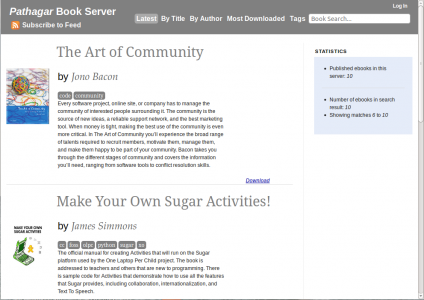Over at OLPC-SF, Sameer and Alex have been exploring new ways to experiment with the bookserver.  They have a new OVA package for Pathagar that you can run: vm-pathagar.ova.zip.  From their blog:
This is a joint effort between me and Alex Kleider, who helped me debug, test and document the endeavor (or endeavour, as Alex would put it). The documentation and virtual machine took shape, largely driven by our need to have the Pathagar Book Server running on a DreamPlug for Madagascar. To that end, we sat down and installed Pathagar on a virtual machine and documented the steps. We used James Simmons’ instructions as a starting point. While the original Pathagar application was written by Sayamindu Dasgupta and Kushal Das, we used Manuel Quinones’ version that has some more tweaks and fixes.
Here’s a screenshot of it in action:

If you are interested in offline libraries, try the Pathagar book server and see what you can do with it.
